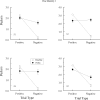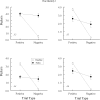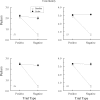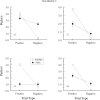Emergent identity matching after successive matching training. II: Reflexivity or transitivity
- PMID: 22287802
- PMCID: PMC3266738
- DOI: 10.1901/jeab.2012.97-5
Emergent identity matching after successive matching training. II: Reflexivity or transitivity
Abstract
Three experiments evaluated whether the apparent reflexivity effect reported by Sweeney and Urcuioli (2010) for pigeons might, in fact, be transitivity. In Experiment 1, pigeons learned symmetrically reinforced hue-form (A-B) and form-hue (B-A) successive matching. Those also trained on form-form (B-B) matching responded more to hue comparisons that matched their preceding samples on subsequent hue-hue (A-A) probe trials. By contrast, most pigeons trained on just A-B and B-A matching did not show this effect; but some did--a finding consistent with transitivity. Experiment 2 showed that the latter pigeons also responded more to form comparisons that matched their preceding samples on form-form (B-B) probe trials. Experiment 3 tested the prediction that hue-hue matching versus hue-hue oddity, respectively, should emerge after symmetrically versus asymmetrically reinforced arbitrary matching relations if those relations are truly transitive. For the few pigeons showing an emergent effect, comparison response rates were higher when a probe-trial comparison matched its preceding sample independently of the baseline contingencies. These results indicate neither a reflexivity nor a transitivity effect but, rather, a possible identity bias.
Keywords: identity bias; key peck; pigeons; reflexivity; stimulus classes; stimulus equivalence; successive matching; symmetrical versus asymmetrical training; transitivity.
Figures













Comment on
-
Reflexivity in pigeons.J Exp Anal Behav. 2010 Nov;94(3):267-82. doi: 10.1901/jeab.2010.94-267. J Exp Anal Behav. 2010. PMID: 21541171 Free PMC article.
Similar articles
-
Concurrent identity training is not necessary for associative symmetry in successive matching.J Exp Anal Behav. 2014 Jan;101(1):10-25. doi: 10.1002/jeab.51. Epub 2013 Sep 30. J Exp Anal Behav. 2014. PMID: 24436073 Free PMC article.
-
Emergent identity matching after successive matching training, I: reflexivity or generalized identity.J Exp Anal Behav. 2011 Nov;96(3):329-41. doi: 10.1901/jeab.2011.96-329. J Exp Anal Behav. 2011. PMID: 22084494 Free PMC article.
-
Reflexivity in pigeons.J Exp Anal Behav. 2010 Nov;94(3):267-82. doi: 10.1901/jeab.2010.94-267. J Exp Anal Behav. 2010. PMID: 21541171 Free PMC article.
-
Reflexivity without identity matching training: A first demonstration.J Exp Anal Behav. 2018 Jan;109(1):125-147. doi: 10.1002/jeab.302. Epub 2018 Jan 10. J Exp Anal Behav. 2018. PMID: 29318632
-
The search for symmetry: 25 years in review.Learn Behav. 2009 May;37(2):188-203. doi: 10.3758/LB.37.2.188. Learn Behav. 2009. PMID: 19380896 Free PMC article. Review.
Cited by
-
Concurrent identity training is not necessary for associative symmetry in successive matching.J Exp Anal Behav. 2014 Jan;101(1):10-25. doi: 10.1002/jeab.51. Epub 2013 Sep 30. J Exp Anal Behav. 2014. PMID: 24436073 Free PMC article.
-
Abstraction, Multiple Exemplar Training and the Search for Derived Stimulus Relations in Animals.Perspect Behav Sci. 2017 Nov 1;41(1):45-67. doi: 10.1007/s40614-017-0112-y. eCollection 2018 Jun. Perspect Behav Sci. 2017. PMID: 32004363 Free PMC article.
-
Humans exhibit associative symmetry in the absence of backward training and stimulus overlap.J Exp Anal Behav. 2025 Jul;124(1):e70020. doi: 10.1002/jeab.70020. Epub 2025 May 6. J Exp Anal Behav. 2025. PMID: 40326233 Free PMC article.
-
A successful search for symmetry (and other derived relations) in the conditional discriminations of pigeons.Conductual. 2015 Apr;3(1):4-25. Conductual. 2015. PMID: 28386579 Free PMC article.
-
A replication and extension of the antisymmetry effect in pigeons.J Exp Anal Behav. 2012 Nov;98(3):283-93. doi: 10.1901/jeab.2012.98-283. J Exp Anal Behav. 2012. PMID: 23144506 Free PMC article.
References
-
- Carter D.E, Eckerman D.A. Symbolic matching by pigeons: Rate of learning complex discriminations predicted from simple discriminations. Science. 1975;187:662–664. - PubMed
-
- Hogan D.E, Zentall T.R. The role of identity in the learning and memory of a matching-to-sample problem by pigeons. Bird Behaviour. 1981;3:27–36.
Publication types
MeSH terms
Grants and funding
LinkOut - more resources
Full Text Sources

